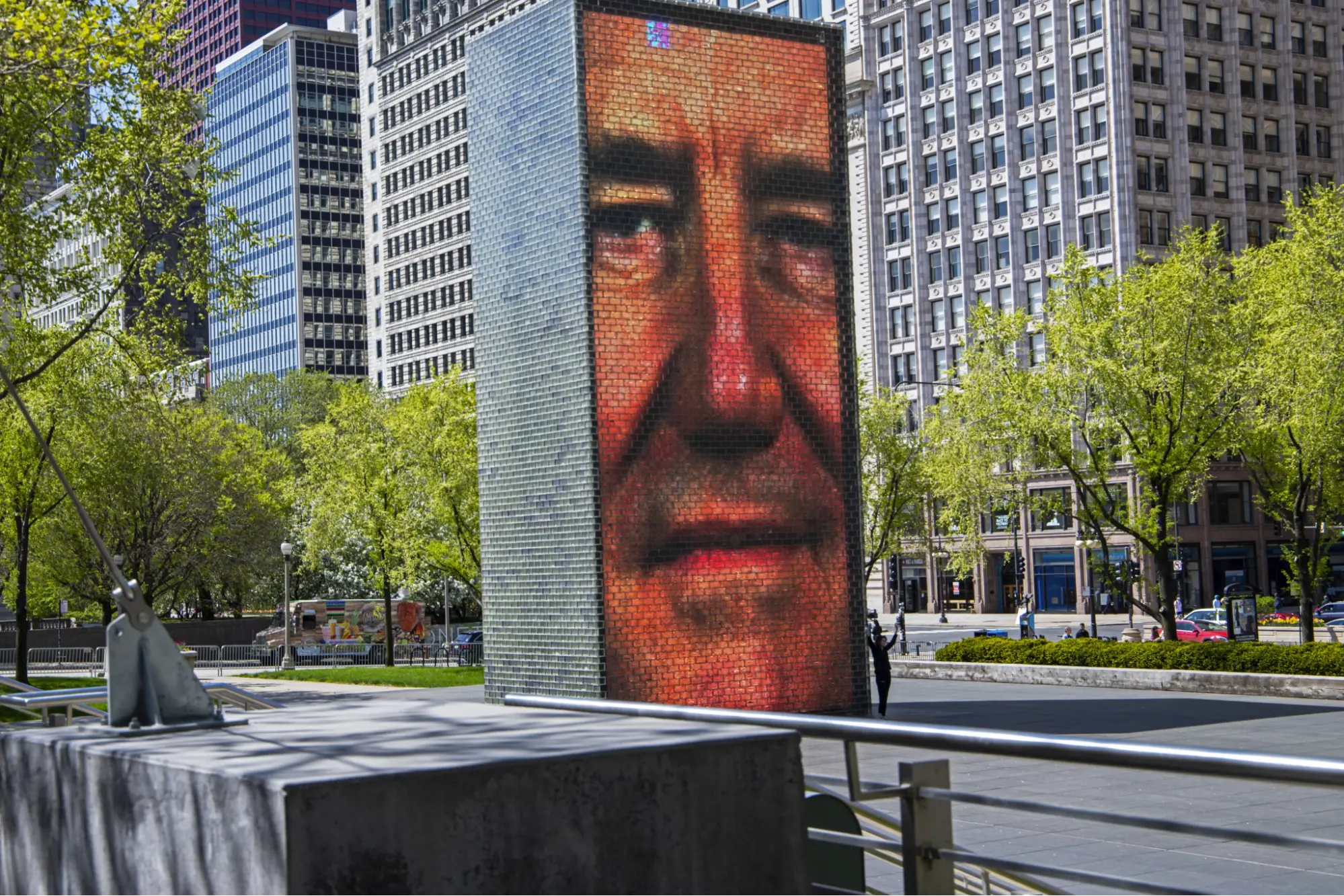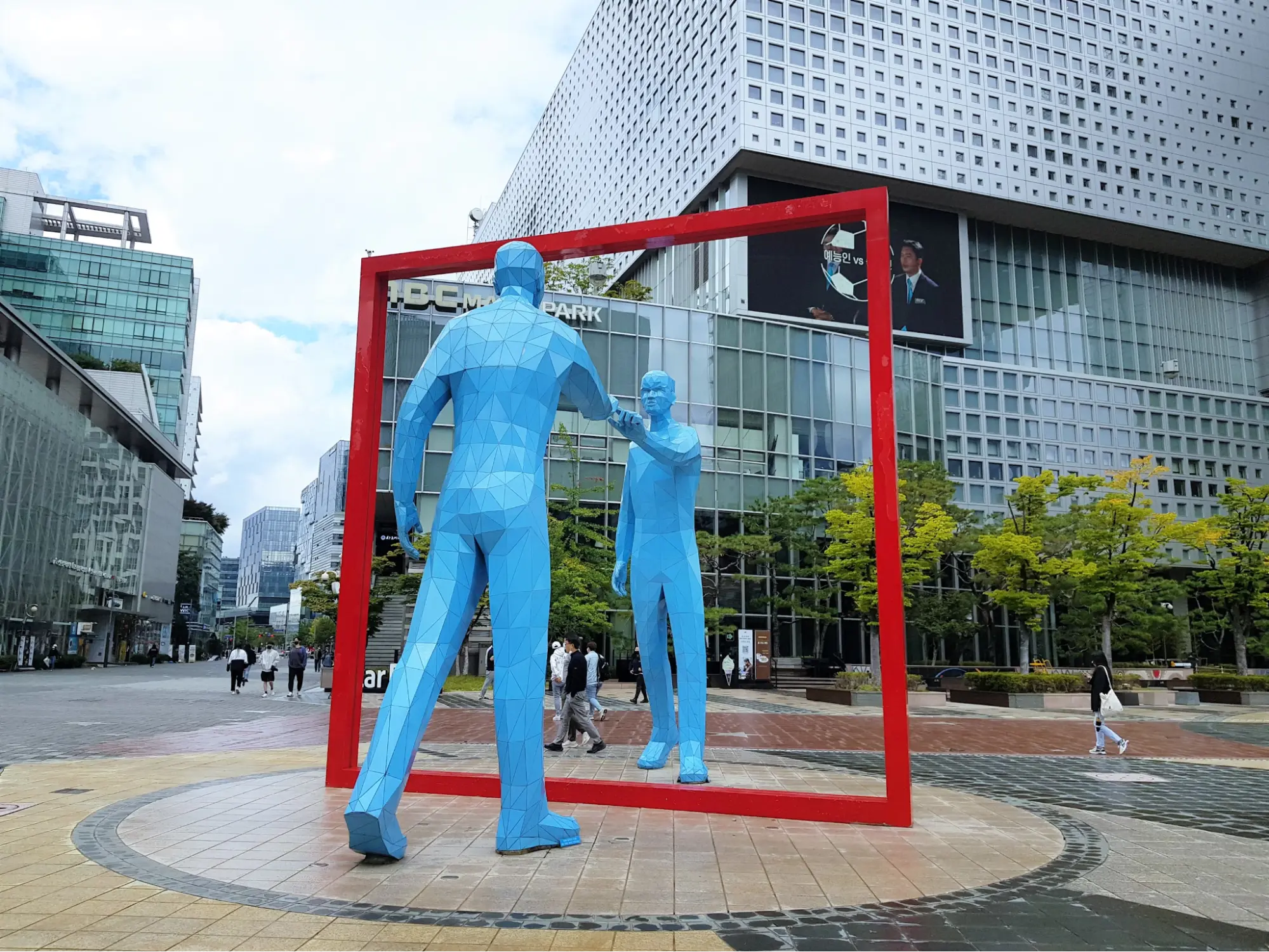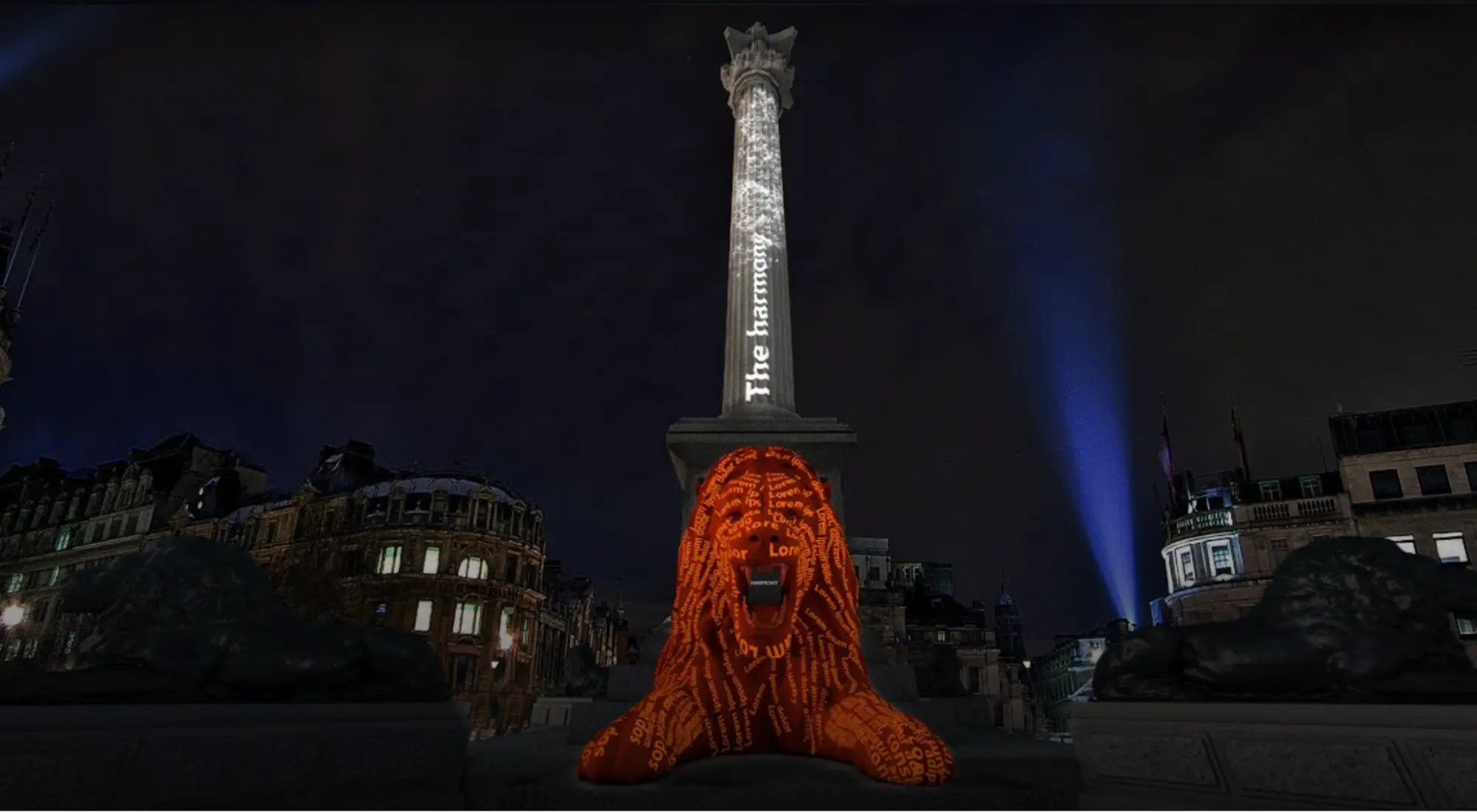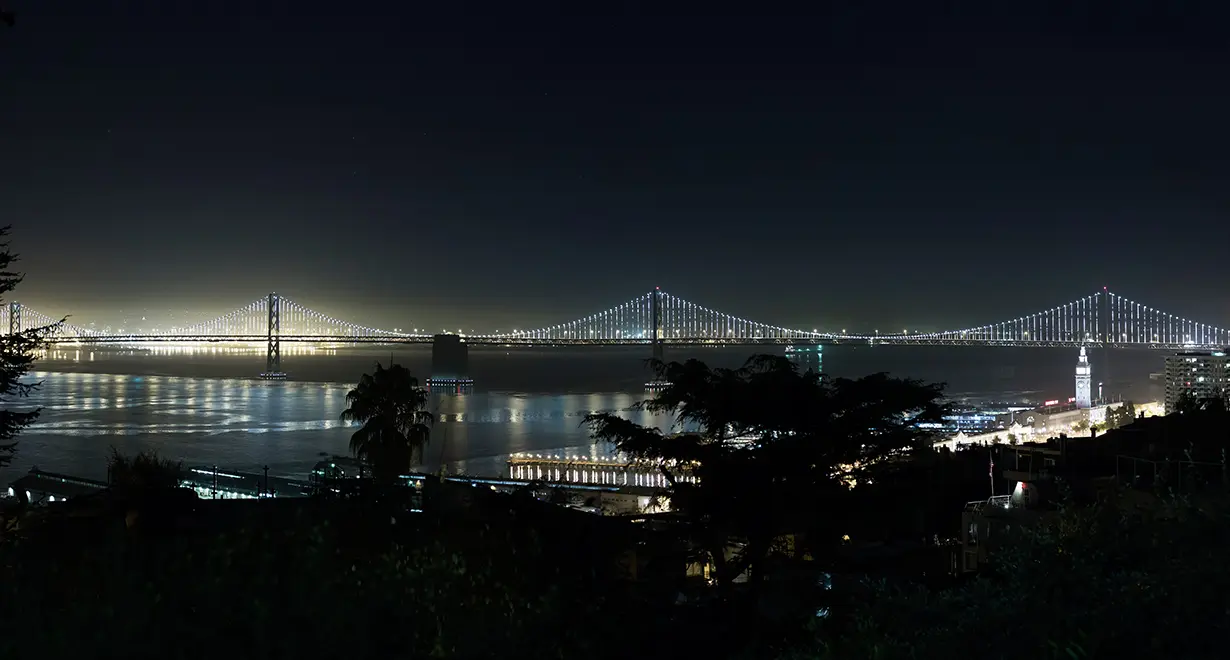What Is Digital Public Art?

Digital public art is temporary or permanent art that integrates technology and digital media, transforming urban environments into interactive, dynamic canvases for artistic exploration aiming to foster public interaction, reshape urban environments, promote community connections, advance artistic creativity, and broaden access to art.
To achieve these purposes, digital public art operates on its own set of core principles: interactivity, technological foundation, dynamism, and interestingness.
Given its unique nature, digital public art can be classified in several ways — based on how it’s experienced, the technologies involved, and the context in which it’s created or displayed.
In practical terms, digital public art enhances urban identity by delivering personalized experiences, reflecting local culture, enabling dynamic interactions, supporting social engagement, and fostering a sense of collective identity. It transforms public spaces into platforms for connection and storytelling, adding both cultural and emotional value to the urban landscape.
Some prominent examples of digital public art include Please Feed the Lions, The Bay Lights, and Rain Room — each demonstrating how digital technology can turn public space into something shared, interactive, and memorable.
To successfully bring such projects to life, partnering with public art agencies like MTArt Agency is essential. Their support ensures that projects receive the necessary funding, accessibility considerations, and curatorial oversight to align with broader cultural, social, and urban development goals — making the commissioning process smoother, more strategic, and ultimately more impactful.
What Is the Purpose of Digital Public Art?
The purpose of digital public art includes fostering public interaction, reshaping urban environments, promoting community connections, advancing artistic creativity, and broadening access to art.
By incorporating digital media, this form of art creates dynamic, immersive, and participatory experiences beyond traditional public art’s static presence.
Digital public art uses technology to engage viewers in new ways, offering a sense of interaction and involvement. A notable example is MTArt artist Jesse Woolston, who created a stunning digital installation for the One&Only — One Za’abeel hotel, showing how this medium can elevate an environment through modern digital artistry.
Thus, the key purposes of digital public art are:
- Enhancing Public Engagement: Digital public art invites direct interaction by utilizing technologies like touchscreens, motion sensors, augmented reality (AR), or mobile apps.
- Transforming Urban Spaces: Digital art changes public spaces through interactive technologies like projection mapping, LED displays, or augmented reality.
- Encouraging Social Connection: Digital art creates dialogue by integrating social media and user-generated content.
- Pushing Artistic Innovation: Digital public art incorporates new technologies such as projections, virtual reality (VR), and artificial intelligence (AI). These technologies challenge traditional boundaries of art, allowing for creative, immersive storytelling that sparks new conversations and pushes the limits of artistic expression.
- Making Art More Accessible: Digital public art removes barriers by displaying artwork in public spaces, making it accessible to everyone. It offers inclusive experiences for all, especially for those who may not have the opportunity to visit galleries or museums, ensuring art reaches a wider audience.
While traditional public art, such as statues or murals, typically remains fixed in place with the intent to inspire awe or contemplation, digital public art introduces a dynamic and evolving aspect. Unlike the static nature of traditional art, which remains unchanged, digital installations can transform over time, adapting to their environment and allowing for interaction.
New Core Principles of Digital Public Art

New core principles of digital public art are interactivity, technological foundation, dynamism, and interestingness.
As digital technologies become integral to artistic expression, they change how art communicates with its audience. Instead of simply being observed, digital public art invites participation, movement, and emotional engagement. These shifts have introduced a new set of core principles that redefine what public art can be in the digital age.
In the past, public art was typically static, offering a one-way experience where viewers passively observed the piece. But digital art challenges this passivity.
A striking example is MTArt and artist Claire Luxton, who projected her vibrant digital artworks onto the iconic Marble Arch and lighthouses around the UK. By doing so, she brought interactivity and dynamism to traditionally immobile monuments, transforming cultural heritage into living, responsive experiences.
Let’s look more closely at the new principles shaping digital public art.
Interactivity
Interactivity is the principle that allows viewers to actively engage with a work of art rather than simply observe it. In digital public art, this can mean anything from triggering visual changes through motion sensors to altering soundscapes with physical presence or input via a smartphone.
This is a new core principle because traditional public art has historically been non-interactive — static sculptures or murals designed to be appreciated from a distance. With the rise of digital technologies, artists now have the tools to create responsive environments that react to human behavior in real time.
Digital public art often incorporates interactive elements, allowing viewers to engage with the artwork and influence its presentation. This shift turns spectators into participants, making the experience more personal and emotionally engaging. The art becomes a shared, evolving moment rather than a fixed display — something made possible only through the integration of interactive technology.
Technological Foundation
The technological foundation is a principle of digital public art, which relies on digital technologies like code, computation, and data to create and display art in public spaces. This foundation enables entirely new artistic formats—from algorithm-driven visuals to sensor-based installations—and expands both creative possibilities and public engagement.
It is a new core principle because digital public art is built on technological systems, unlike traditional public art that depends on physical materials like stone, metal, or paint. These systems are not just tools but essential components of the artwork itself. Without them, the piece would not exist or function.
The emergence of this principle is driven by advancements in media technology, which allow artists to integrate real-time data, responsive programming, and immersive interfaces into their work. As a result, digital public art is no longer constrained by static form or passive display—its very essence is shaped by technology’s evolving capabilities.
Dynamism
Dynamism is a principle and defining characteristic of digital public art, enabling immersive, interactive, and responsive experiences that go far beyond the fixed nature of traditional art forms.
This is a new core principle because digital public art introduces movement, change, and responsiveness into the public art space — something that static sculptures or murals cannot offer. The reason for this shift lies in the integration of digital tools, which allow artworks to evolve over time, react to their surroundings, and engage people in real-time.
- Beyond Static Forms: Digital public art moves past the stillness of traditional forms by incorporating video, animation, interactive projections, and other dynamic mediums that are constantly in flux.
- Immersive and Interactive Experiences: It leverages technology to create multisensory environments that blur the boundaries between the audience, the space, and the artwork itself.
- Dynamic and Responsive: Motion sensors, touch interfaces, and augmented reality allow artworks to respond to passersby, creating a live dialogue between the viewer and the piece.
- Reflecting Contemporary Urban Life: Dynamism in digital public art mirrors the ever-changing rhythm of modern cities, transforming static public spaces into fluid, engaging, and thought-provoking environments.
Interestingness
Interestingness is a principle of digital public art that refers to the artwork’s ability to capture and sustain public attention through surprise, novelty, emotional resonance, or sensory impact.
Digital public art operates in environments saturated with stimuli — urban spaces filled with ads, noise, and distractions. To stand out, it must be visible and intrinsically engaging. Unlike traditional public art, which often relies on symbolic or historical value, digital works use movement, light, sound, interactivity, and real-time change to create immediate appeal and curiosity.
The rise of digital technologies enables artists to create artworks that adapt, respond, or evolve — qualities that naturally draw people in. Interestingness emerges as a necessary artistic strategy to compete for attention in contemporary public spaces and make the audience stop, engage, and remember the experience.
What Are the Classifications of Digital Public Art?
Digital public art can be classified in several ways depending on how it’s experienced, what technologies it uses, and the context in which it’s created or displayed.
By Level of Interaction
Classifying digital public art by its level of interaction helps us understand how audiences engage with and influence the artwork, whether the interaction is passive, reactive, interactive, or participatory.
Interaction is especially important in digital public art because it’s often designed to evolve based on viewers’ presence, movement, or input — unlike traditional public art, which remains static and offers little or no feedback to the audience.
In traditional public art, engagement typically stops at observation. People might take photos or interpret meaning, but the artwork doesn’t respond. Digital public art changes that. It introduces a two-way exchange where the viewer can become a participant or co-creator of the piece.
The most common types of interaction in digital public art include:
- Passive Interaction. Viewers do not influence the artwork, but their presence is still considered. Examples include light or sound shows projected in public spaces — captivating but not responsive. (e.g., a digital mural that plays a visual loop on a building facade)
- Reactive Interaction. The artwork responds to external inputs like motion, sound, or light sensors. A passerby might trigger visual effects or audio shifts simply by walking past or clapping. (e.g., a sidewalk projection that changes color as people move across it)
- Interactive. The audience actively engages through touchscreens, apps, or mobile devices, directly influencing the artwork’s behavior or appearance. (e.g., a digital sculpture whose colors change based on input from a public touchscreen)
- Participatory. Viewers contribute user-generated content, such as photos, text, or drawings, which become part of the artwork itself. This form turns spectators into co-creators. (e.g., an installation that pulls real-time messages from the public and displays them in a visual stream)
By Technology
The classification by technology refers to categorizing digital public art based on the specific tools, systems, and technological mediums employed to create and deliver the artwork, such as augmented reality (AR), virtual reality (VR), projection mapping, LED sculpture systems, artificial intelligence (AI), or 3D printing to offer real-time interaction and adaptive experiences.
The importance of classifying digital public art by technology lies in how different technologies allow artists to explore new artistic realms, from manipulating light to crafting virtual worlds, ultimately redefining the public art experience. Digital public art transforms once-static monuments or displays into dynamic works that adapt to their environment, respond to viewers, and evolve based on data or real-time input.
Consider the following common technologies used in digital public art.
- Augmented Reality (AR) adds digital layers to the real world, enabling viewers to see virtual objects, information, or animations overlaid on physical spaces through smartphones or AR glasses. (e.g., a historical monument augmented with additional digital information or animated art elements when viewed through a mobile device)
- Virtual Reality (VR) immerses viewers in a completely virtual environment, often requiring headsets or specialized equipment. This creates a fully immersive, 360-degree experience that disconnects from the physical world. (e.g., a VR installation that transports viewers to a digitally created landscape or interactive world)
- Projection Mapping projects images or animations onto irregular surfaces, turning buildings or monuments into dynamic canvases. The artwork can adapt to the structure’s shape and change based on the time of day or interaction. (e.g., a building transformed into a canvas for a stunning visual display that changes throughout the evening)
- LED Sculpture Systems allow artists to create dynamic, light-based sculptures that can change colors, patterns, and intensity, offering an immersive visual experience. These sculptures can be programmed to evolve in response to environmental or audience input. (e.g., a towering LED installation that shifts its colors based on the crowd’s movement)
- AI can be used to create installations that respond to data, behavior, or environmental changes. These installations use algorithms to adapt the artwork in real time, responding to the viewers’ behavior or emotions, making each interaction unique. (e.g., an art piece that changes based on the viewer’s emotions, detected through facial recognition)
- 3D Printing allows artists to create complex, detailed sculptures that would otherwise be impossible or too costly to craft by hand. When the technology is used in conjunction with sensors or other digital systems, it can also transform sculptures into new forms interactively. (e.g., a 3D-printed sculpture that can change shape when interacted with through motion sensors)
By Purpose/Context
The classification by purpose/context categorizes digital public art based on the intentions behind its creation and its specific roles within the community or environment, like educational, commemorative, aesthetic, advocacy and social commentary.
Unlike traditional public art, where the purpose is often to celebrate a figure, event, or place, digital public art can serve a broader range of functions, from educating the public to promoting social change. By tailoring the artwork to specific goals, digital public art can be designed to engage audiences on a deeper, more meaningful level, enhancing their connection with both the art and its surrounding context.
Consider the most common purposes and contexts in digital public art.
- Educational (e.g., historical overlays). Digital public art can provide educational value by overlaying historical information or interactive content on existing monuments, buildings, or spaces. This allows the audience to gain new insights into the cultural or historical significance of a location, enriching the public’s understanding of its surroundings. (e.g., projecting historical images or facts onto a monument to reveal its past)
- Commemorative (e.g., projection shows). Digital public art is often used for commemorative purposes, such as honoring historical figures, events, or achievements. Projection shows, for instance, can create dynamic tributes to notable figures or milestones by transforming public spaces into emotional, commemorative environments. (e.g., a projection on a city building to mark a significant national holiday or event)
- Aesthetic/Experiential. Some digital public art pieces prioritize the visual and sensory experience over a specific narrative or message. These artworks are designed to evoke emotion, wonder, or curiosity by using digital technology to create immersive and visually striking installations that engage the public in an aesthetic experience. (e.g., a large-scale interactive light show that changes color and pattern based on the audience’s movements)
- Advocacy and Social Commentary. Digital public art can also serve as a platform for advocacy, addressing social, political, or environmental issues. By incorporating technology, these artworks often push boundaries, making statements that resonate with contemporary concerns and fostering dialogue and reflection on pressing societal matters. (e.g., a digital projection addressing climate change by showing the effects of environmental destruction on public landmarks)
While traditional public art often serves a fixed, singular purpose — such as marking an event or honoring a person — digital public art opens the door to multipurpose functions that adapt to the needs of the audience and the surrounding environment. It reflects the values of the time and invites viewers to interact, learn, reflect, and engage with the artwork in meaningful ways.
Digital Public Art and Urban Identity
Digital public art enhances public identity by creating personalized experiences, reflecting local culture, enabling dynamic interactions, and fostering social engagement. Technologies like AR, projection mapping, LED sculptures, and AI installations help communities connect to their surroundings and each other in meaningful ways.
- Personalized Experiences through Augmented Reality (AR). AR overlays digital content on the physical world, allowing users to engage with the artwork via smartphones or AR glasses. This fosters a connection between community members and their surroundings, creating a sense of ownership and shared identity.
- Reflecting Local Culture through Projection Mapping. Projection mapping transforms surfaces like buildings into canvases for dynamic art. It celebrates cultural heritage by projecting local stories or artistic expressions, reshaping public spaces and fostering pride in the community’s cultural roots.
- Dynamic Interaction through LED Sculpture Systems. LED sculptures use lights that change in response to user movement, offering a dynamic visual experience. These interactive installations engage passersby, making them feel involved in the evolving identity of the urban space.
- Social Engagement through AI-Responsive Installations. AI-responsive installations adapt based on user interaction, creating personalized experiences. These evolving artworks reflect the community’s dynamic nature, encouraging inclusivity and reinforcing the connection between people and place.
Digital public art redefines urban identity by transforming public spaces into interactive, ever-changing environments. It fosters community engagement, promotes place-making, and blends historical and contemporary narratives to create a unique, evolving urban identity that resonates with all.
Responsiveness and Personalization in DPA
Digital public art (DPA) influences people’s self-awareness and self-expression by offering new ways to engage with public spaces, allowing for personalized interactions and adaptive responses. Through interactive and immersive experiences, DPA empowers individuals to shape their environment and express themselves dynamically.
- Self-Awareness: Individuals become more aware of their presence in public spaces by engaging with digital art. Interactive elements, such as motion sensors or AR, allow users to see their impact on the artwork, reflecting their actions and encouraging a deeper connection with their surroundings.
- Self-Expression: DPA opens up new avenues for personal expression, as users can influence, alter, or contribute to the artwork. Features like user-generated content or mobile app-based interactions enable people to leave a digital imprint on public art, showcasing their creativity and individuality.
- Adaptive Engagement: DPA’s dynamic nature, where art responds in real-time to people’s actions, fosters a sense of co-creation. As the artwork adapts to the viewer, it encourages personal engagement, inviting people to explore, modify, and personalize their interactions, making the experience unique to each individual.
- Inclusive and Accessible Expression: Digital public art allows for diverse forms of self-expression, as it can include various technologies like AR, AI, and projection mapping, ensuring that all individuals, regardless of background or ability, have a way to participate and be part of the public narrative.
Digital Public Art Examples
Some prominent examples of digital public art include Please Feed the Lions, The Bay Lights, and Rain Room.
Please Feed the Lions

Please Feed the Lions is a digital public art installation by Es Devlin, created for Trafalgar Square, London, in September 2018 as part of the London Design Festival. The installation featured a lion sculpture powered by a deep learning algorithm developed by Ross Goodwin. The algorithm, trained on 19th-century poetry, allowed passersby to input words via a tablet, generating real-time poetic responses.
These two-line poems were displayed on an LED screen inside the lion’s mouth during the day and projected onto Nelson’s Column at night. The installation’s interactive nature invited the public to engage directly with the artwork, making them part of the creative process. Through this fusion of art and technology, Please Feed the Lions fostered a collective, participatory experience, uniquely and dynamically blending machine learning and human expression.
The Bay Lights

The Bay Lights is a monumental digital public art installation created by artist Leo Villareal, located on the San Francisco-Oakland Bay Bridge. Originally illuminated on March 5, 2013, to celebrate the bridge’s 75th anniversary, it was designed to transform the iconic bridge into a dynamic light sculpture. The installation featured 25,000 white LED lights controlled by a sophisticated computer system that generated abstract, non-repeating patterns inspired by water, traffic, and local weather.
The purpose of The Bay Lights was to enhance the bridge’s visibility and turn it into a permanent, ever-changing art piece visible from the San Francisco waterfront. Although the installation was initially intended as a temporary display, it became so popular that public demand led to its continuation as a permanent fixture, with the lights being re-lit on January 30, 2016.
While there were no interactive components for public participation, the installation provided a passive viewing experience that captivated both tourists and locals. The Bay Lights quickly became a cultural landmark, drawing significant attention to the Bay Bridge. Although the installation was turned off in 2023 due to maintenance challenges, plans to re-install an updated version, Bay Lights 360, expected to debut in March 2025.
Rain Room

Rain Room is an immersive installation created by the London-based art collective Random International, founded in 2005 by Hannes Koch and Florian Ortkrass. First presented at London’s Barbican Centre in 2012, it offers visitors the illusion of controlling rainfall.
The installation comprises a darkened room where motion sensors detect visitors’ movements, pausing the simulated rain above them. This technology allows individuals to navigate a continuous downpour without getting wet, highlighting the interplay between human presence and technological responsiveness.
Rain Room has been showcased globally, including at New York’s Museum of Modern Art (MoMA) in 2013 and as a permanent installation at the Sharjah Art Foundation in the United Arab Emirates starting in 2018. The Sharjah installation is housed in a purpose-built structure, providing visitors with a unique opportunity to experience this fusion of art and technology in a desert setting.
Through Rain Room, Random International explores the relationship between humans and machines. It offers a contemplative space where technology responds to human presence, inviting reflection on our interaction with the environment.
How to Commission Digital Public Art for Your Space?
Partnering with an experienced agency like MTArt Agency is the best way to ensure a successful and impactful project when commissioning digital public art for a space.
MTArt Agency specializes in transforming public spaces with innovative digital art that captivates, engages, and inspires local communities. With over 15 years of experience delivering large-scale projects across the US, UK, Europe, and the Middle East, their Public Art Department is fully equipped to handle every aspect of a digital art commission, from conception to completion.
Here’s why commissioning digital public art through MTart public art agency is the ideal choice:
- Expertise in Digital and Public Art: MTArt Agency excels in creating digital installations that seamlessly integrate into public spaces. Their team understands the intricacies of digital media and technology, ensuring that the commissioned art becomes a meaningful interaction with the community beyond just a visual spectacle.
- World-Class Artists: The agency represents a roster of renowned artists who are digital and public art leaders. From Don Diablo, who blends electronic music and digital installation, to Ivona Tau’s AI-driven works in photography, MTArt also represents artists like Andres Reisinger, Ouchhh Studio, and Lela Amparo — ensuring that every project stands out.
- Comprehensive Consultancy and Project Management: MTArt Agency provides expert consultancy from the outset, guiding clients through commissioning. Their team handles all aspects of project management, including logistics, installation, and technical considerations, ensuring the smooth execution of the project in alignment with the client’s goals.
- Proven Track Record: MTArt Agency has earned a strong reputation for delivering successful projects transforming urban spaces and enriching local cultures. Their collaborations with developers, architects, and cultural institutions have helped create landmark installations worldwide.
- Tailored Solutions for Every Space: MTArt works closely with clients to design digital art tailored to the location and audience. Whether a temporary installation or a permanent fixture, their expertise ensures that the artwork enhances the space’s identity.